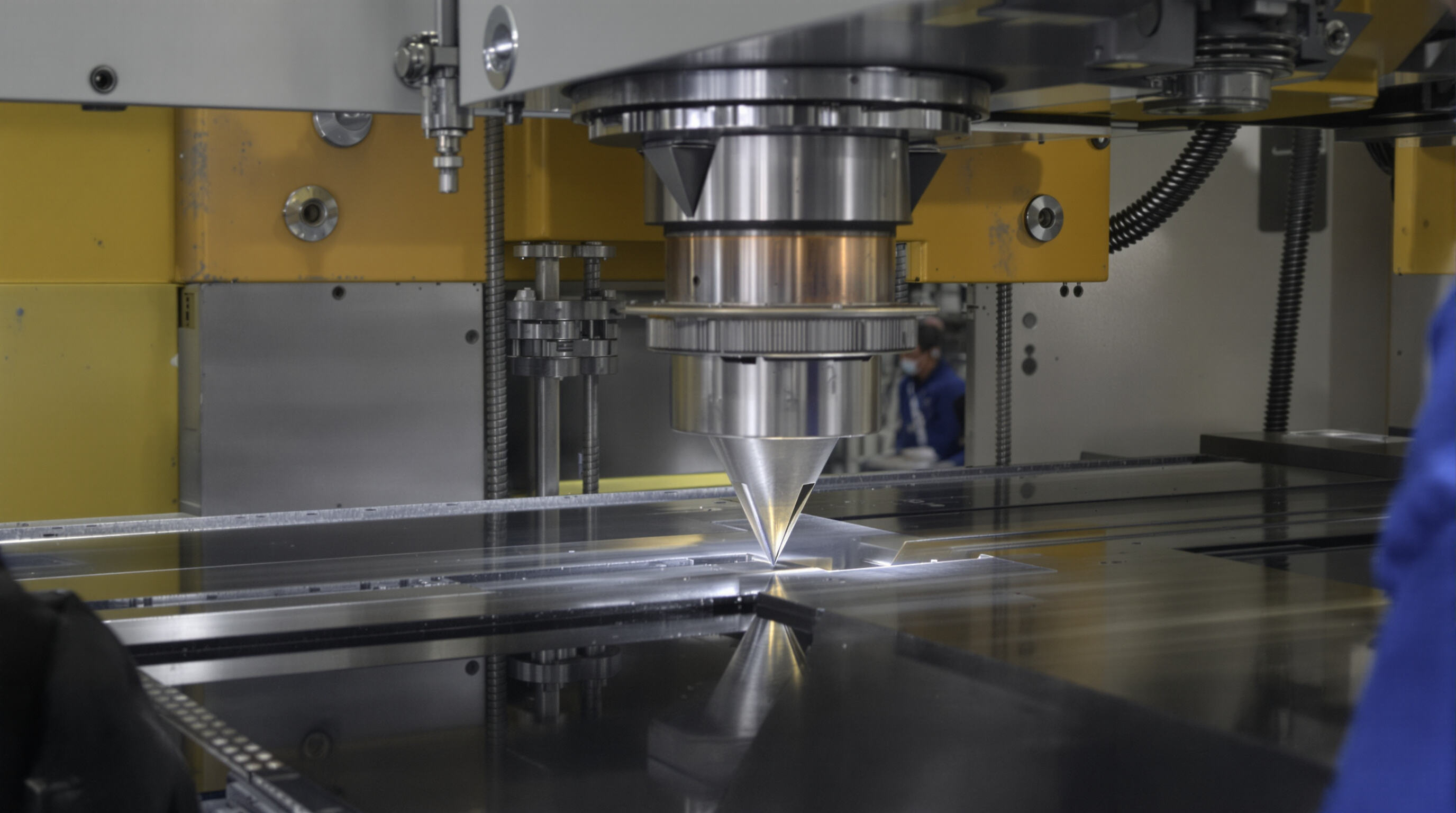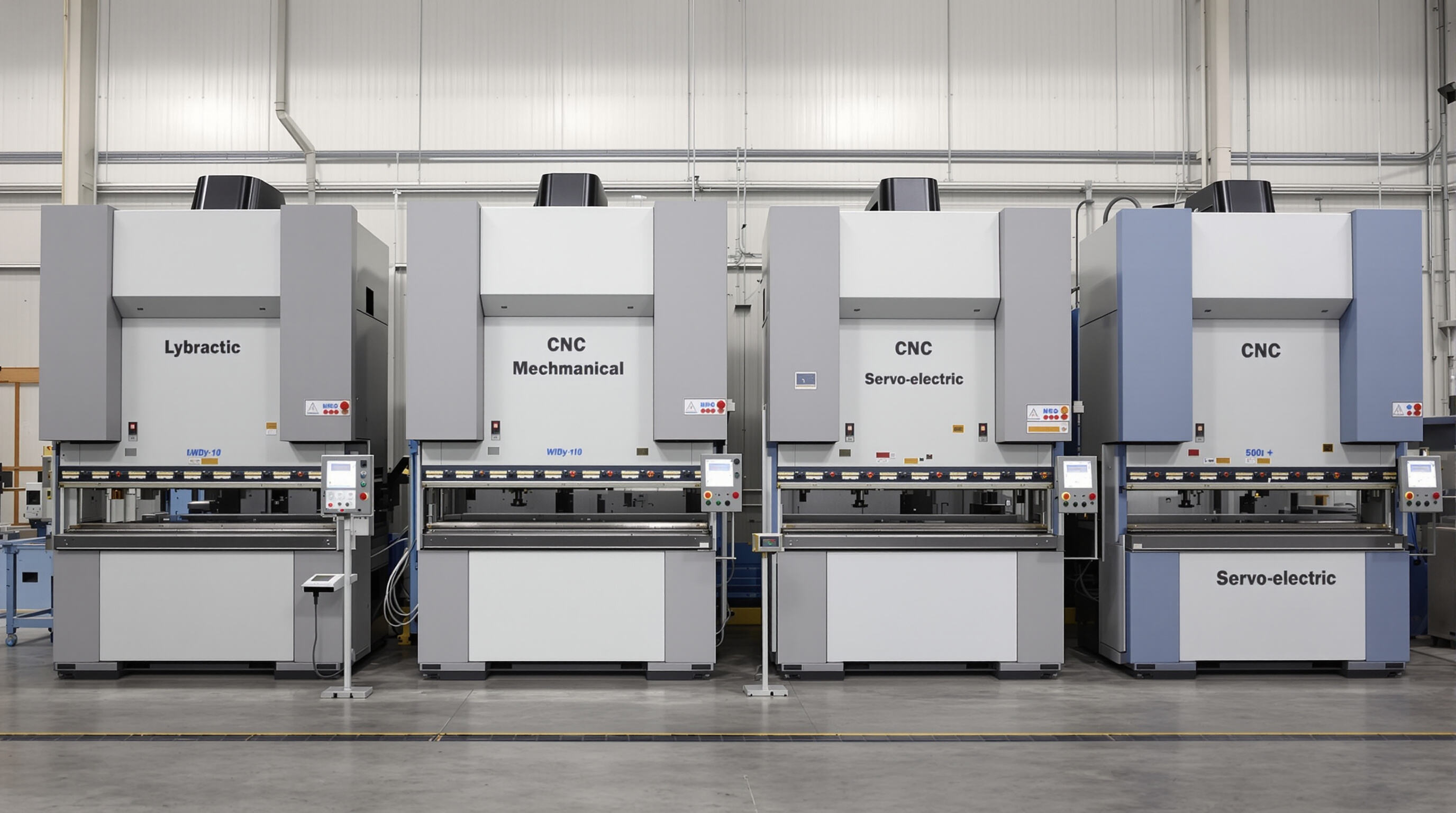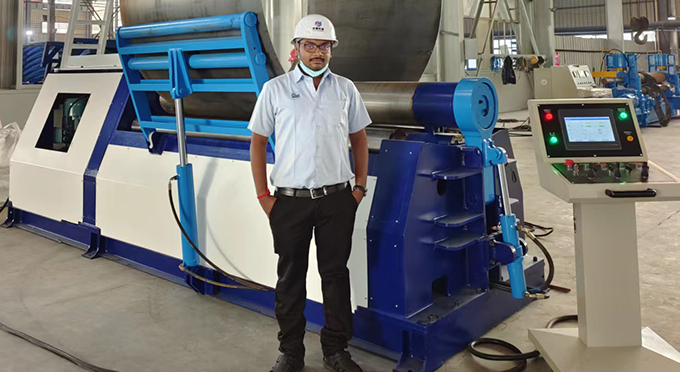How Press Brakes Work: Principles of Force, Tooling, and Bending

Understanding the Basic Function of a Press Brake
Press brakes work by shaping metal sheets when they apply just the right amount of pressure using specially aligned tools. These machines typically have three main parts: a solid base, a moving part called the ram, and matching punch and die combinations. When operating, the metal sits on the base as the ram pushes the punch down, squeezing the metal against the die to create accurate bends. What starts as a simple flat sheet gets transformed into all sorts of angled pieces needed for things like air conditioning ductwork and car body structures. The versatility of this method makes it indispensable across many manufacturing industries today.
Working Principle and Bending Process of Press Brakes
The bending sequence follows four key stages:
- Positioning: The operator aligns the sheet against the back gauge to ensure accurate bend placement.
- Tool pairing: A V-shaped die and corresponding punch are selected based on material thickness and desired bend angle.
- Force application: The ram descends at controlled speeds, pressing the metal into the die. Hydraulic systems power 68% of industrial press brakes due to their consistent pressure delivery, as noted in the 2024 Metal Fabrication Trends Report.
- Springback compensation: To counteract elastic recovery, operators slightly overbend the material, ensuring the final angle meets specifications after release.
The Role of Force and Tooling in Shaping Metal Sheets
The quality of bends really comes down to two main factors: how much force is applied and the shape of the tools used. When working with thicker materials, the tonnage goes way up. Take 12-gauge steel as an example it typically needs around 60 tons per foot. Compare that to 18-gauge aluminum which only asks for about 8 tons per foot. The narrower the die opening gets, the sharper those bends become, although this does come at the cost of needing even more force. These days, most modern CNC machines handle all these adjustments themselves. They tweak the ram speed and manage crowning so that angles stay pretty much consistent throughout production runs, usually keeping things within about plus or minus 0.1 degrees. This level of precision makes a big difference in manufacturing outcomes.
Types of Press Brakes: Hydraulic, CNC, Mechanical, and Electric

Hydraulic Press Brakes: Power, Control, and Widespread Industrial Use
Hydraulic press brakes use pressurized fluid to generate bending force, making them ideal for shaping thick steel plates up to 1 inch. Their adjustable tonnage and ram speed suit heavy-duty applications like shipbuilding and structural steel fabrication. Advanced models with proportional valve systems achieve ±0.0004" repeatability, even under full load.
CNC Press Brakes: Enhancing Precision and Repeatability
CNC press brakes automate angle correction and backgauge positioning, delivering bending accuracy within ±0.1°. Preprogrammed tool paths reduce setup times by 60–70% compared to manual systems, making them essential for aerospace components and high-mix production environments. Some models integrate laser measurement to dynamically compensate for material springback.
Mechanical Press Brakes: Speed vs. Flexibility
Mechanical press brakes use flywheel-driven cranks to achieve rapid cycling—up to 50 bends per minute—making them well-suited for high-volume stamping of thin-gauge metals (≥3mm). However, their fixed stroke lengths and limited programmability restrict use to simple, repetitive bends such as those in HVAC ducting or electrical enclosures.
Servo-Electric Press Brakes: Efficiency and Environmental Benefits
Servo-electric press brakes replace hydraulic oil with brushless motors, reducing energy consumption by 30–40%. They offer exceptional positioning accuracy (±0.0002") and operate without fluid leaks, cutting maintenance and disposal costs. With noise levels below 75 dB, they meet ISO 14001 sustainability standards and are increasingly adopted in electronics and medical device manufacturing.
Comparing Press Brake Types: Performance, Cost, and Application Fit
| Factor | Hydraulic | CNC | Mechanical | Servo-Electric |
|---|---|---|---|---|
| Precision | ±0.001" | ±0.0005" | ±0.01" | ±0.0002" |
| Speed | 10–20 bends/min | 15–30 bends/min | 30–50 bends/min | 20–40 bends/min |
| Energy Use | High | Moderate | Low | Very Low |
| Best For | Heavy plates | Complex geometries | High-volume | Thin, precision parts |
In the world of heavy fabrication where budget matters most, hydraulic systems remain the go to choice, usually falling somewhere in the $50 thousand to $300 thousand range. The servo electric versions come at a steeper price tag, anywhere from around $120k all the way up to $600k, but manufacturers pay extra because these machines deliver exceptional accuracy and run more efficiently. These types of equipment find their place in sectors where getting measurements just right is absolutely essential and green credentials matter a lot too. For smaller job shops dealing with all sorts of different materials and intricate components though, CNC press brakes strike that sweet spot between capability and practicality, making them pretty popular across various workshops.
Core Components and Their Impact on Bending Accuracy
Frame and Bed: Ensuring Structural Stability Under Pressure
The frame and bed make up the backbone of any press brake, holding strong against bending forces when working with heavy materials. Steel frames built for rigidity help keep things stable instead of letting them bend out of shape. Some studies show even small issues matter a lot here. We're talking about something as tiny as 0.06 mm getting off track could throw off angles by nearly 0.17 degrees. That's why hardened guideways are so important for keeping everything aligned properly between the ram and bed surface. And don't forget those T-slot clamping systems either. They grip sheets firmly in place, which means no slipping happens during bending operations. This setup makes all the difference when dealing with big pieces that need consistent results throughout.
Ram and Punch: Dynamics of Force Transmission and Control
Precision-ground rams distribute force evenly along the punch, with servo-hydraulic systems capable of adjusting stroke increments as fine as 0.01 mm. Proper punch alignment reduces angular errors by up to 65% compared to worn or misaligned tooling. Real-time tonnage monitoring detects imbalances exceeding ±2%, enabling automatic corrections via CNC controls.
Die Selection and Its Impact on Bend Accuracy and Tolerances
The width of V-die openings plays a big role in determining both bending accuracy and what's considered the smallest acceptable flange size. Most shops stick to a guideline suggesting the opening should be around eight times whatever the material thickness happens to be, keeping bends within about half a degree tolerance. Tool steels that have been hardened to between HRC 58 and 62 typically last through well over ten thousand bending operations. For those working with tougher materials, coating the dies makes a noticeable difference in controlling springback variations. When punch and die radii don't match up properly, it often leads to serious overbending issues, sometimes going beyond three degrees when dealing with 16 gauge stainless steel parts. This kind of error can really throw off production schedules and quality control efforts if not caught early on.
Backgauge Systems: Enabling Repeatability and Dimensional Precision
Multi-axis CNC backgauges position blanks with ±0.05 mm repeatability using linear encoders and servo motors. Models with collision detection reduce setup errors by 40% through automatic Z-axis retraction. Integrated laser measurement compensates for thickness variations up to 0.2 mm, adjusting bend deductions in real time to maintain ±0.25 mm dimensional accuracy.
Bending Methods: Air Bending, Bottom Bending, and Coining
Air Bending: Versatility and Reduced Tool Wear
Air bending works when the punch pushes metal into a V-shaped die but doesn't make complete contact, so there's actually some space left between them. What makes this technique special is that it needs way less force compared to coining methods, which means tools last longer before needing replacement. With just one basic die setup, manufacturers can create bends ranging anywhere between about 30 degrees all the way up to around 165 degrees simply by adjusting how deep the punch goes. This kind of versatility really comes in handy during prototype development phases or when working with different types of metals like aluminum alongside tougher stuff such as stainless steel.
Bottom Bending: Improved Accuracy With Higher Tonnage
When bottom bending is applied, the metal sheet gets pressed all the way down into the die until it matches the exact angle of the die itself. While this technique needs anywhere from three to five times more force compared to air bending methods, there's a big plus side too: springback drops significantly between fifty to seventy percent. The result? Angle consistency stays within half a degree give or take. However, manufacturers need separate tools for every different angle and material thickness they work with. That makes bottom bending particularly well suited for mass production runs in automotive manufacturing where precision matters most. Car makers rely on this approach when building parts that simply cannot tolerate any variation whatsoever.
Coining: Achieving Extreme Precision Through High Pressure
The coining process really packs a punch, applying force around ten times stronger than regular air bending to reshape materials all the way through their thickness. When the punch pushes metal into the die cavity, it creates those super sharp bends we need, hitting tolerances within half a degree and leaving almost no springback behind. But there's a catch worth mentioning here. The intense pressure wears down tools at about 30 to 40 percent faster rate compared to other methods. Because of this, most shops save coining for high value jobs in aerospace manufacturing or medical device production where getting every micron right actually makes financial sense despite the higher costs involved.
Choosing the Right Bending Method Based on Material and Design
Material properties and design requirements guide method selection:
- Air bending: Best for sheets under 3mm requiring flexibility.
- Bottom bending: Ideal for 3–12mm materials needing high repeatability.
- Coining: Reserved for hardened alloys under 6mm where precision is paramount.
Design complexity also influences choice: air bending accommodates curved or asymmetrical shapes, while coining excels at right-angle folds for enclosures or brackets. For production volume, low-batch runs benefit from air bending’s adaptability, whereas high-volume lines gain efficiency from bottom bending’s speed and accuracy.
Applications and Advantages in Modern Industrial Manufacturing
Key Industries Using Press Brakes: Automotive, Aerospace, Construction, and Electronics
Press brakes play a vital role across various industries that need accurate metal shaping. Car makers depend on these machines to create everything from body panels to chassis pieces and exhaust systems, making sure all parts fit together properly and hold up structurally. When it comes to aerospace applications, press brakes get to work on tough materials like aluminum and titanium to produce essential parts such as aircraft brackets and engine housing components that must pass strict quality checks. Construction companies also find them invaluable for creating strong structural supports and intricate building facades. Meanwhile, in the world of electronics manufacturing, press brakes enable production of enclosures and heat sink designs down to the micron level of precision required by modern technology specifications.
Operational Advantages: Precision, Consistency, Efficiency, and Cost-Effectiveness
Today's press brakes can hit angles within about 0.1 degrees each time, which means parts come out consistent across production runs. The latest stats from fabrication efficiency studies show that when shops switch to CNC controls, they tend to waste around 18% less material overall. Shops report big savings too because automated tool changes and faster setup times mean machines spend 40% less time just sitting there waiting. Take a look at what happens in practice: those heavy duty 1500 ton hydraulic models aren't just bending metal fast either. They'll knock out well over sixty bends an hour even with thick steel plates, all while keeping that same level of precision throughout the whole batch.
Integration with Industry 4.0: Smart Controls and Automated Workflows
Modern CNC press brakes come equipped with smart sensors connected through the Internet of Things, keeping track of things like ram deflection, applied pressure, and tool condition as they work. What makes these machines stand out is their ability to tweak settings on their own so parts stay within incredibly tight tolerances, often down to just a thousandth of an inch. Some manufacturers have taken this even further by connecting their machines to cloud platforms. This lets important operational data flow directly into enterprise resource planning systems, which helps predict when maintenance might be needed before problems actually happen. According to recent industry reports from Machinery Analytics Index (2024), this kind of proactive approach cuts unexpected machine stoppages by around 30%. For companies looking at long term costs, servo electric versions offer another benefit too. They use roughly half the energy per operation compared to older hydraulic models, all while still delivering almost perfect power transfer efficiency at about 98%.
FAQ Section
What are the main types of press brakes?
The main types of press brakes include hydraulic, CNC, mechanical, and servo-electric, each suited for different applications based on precision, speed, and energy use.
How does a press brake maintain bending accuracy?
Bending accuracy is maintained through optimized tooling force, die selection, and advanced backgauge systems. Most modern machines use CNC controls for real-time adjustments.
Which industries commonly use press brakes?
Industries such as automotive, aerospace, construction, and electronics commonly use press brakes for their metal shaping needs.
What is the difference between air bending, bottom bending, and coining?
Air bending requires less force and is versatile for angle variation; bottom bending provides improved consistency with higher tonnage; coining offers extreme precision but wears tools faster.
Table of Contents
- How Press Brakes Work: Principles of Force, Tooling, and Bending
-
Types of Press Brakes: Hydraulic, CNC, Mechanical, and Electric
- Hydraulic Press Brakes: Power, Control, and Widespread Industrial Use
- CNC Press Brakes: Enhancing Precision and Repeatability
- Mechanical Press Brakes: Speed vs. Flexibility
- Servo-Electric Press Brakes: Efficiency and Environmental Benefits
- Comparing Press Brake Types: Performance, Cost, and Application Fit
- Core Components and Their Impact on Bending Accuracy
- Bending Methods: Air Bending, Bottom Bending, and Coining
- Air Bending: Versatility and Reduced Tool Wear
- Bottom Bending: Improved Accuracy With Higher Tonnage
- Coining: Achieving Extreme Precision Through High Pressure
- Choosing the Right Bending Method Based on Material and Design
- Applications and Advantages in Modern Industrial Manufacturing
- FAQ Section




